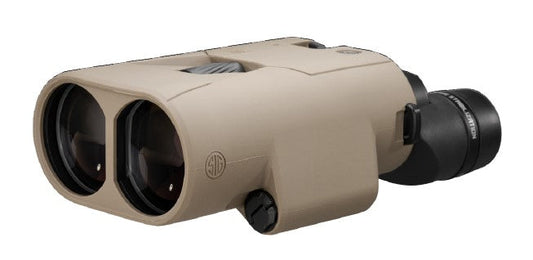

Sig Sauer ZULU6 HDX Pro 18x50mm Binoculars provide advanced image stabilization through OmniScan technology, ensuring a steady view even when in motion. The user-selectable modes, including Scan Mode and Target Mode, allow for tailored viewing experiences, making them ideal for various outdoor activities such as wildlife observation, hunting, or nature photography. With a significant light transmission boost of up to 25% from HDX-Glass, these binoculars excel in low-light conditions, ensuring clarity at dawn or dusk.
Weighing just 33.97 oz and featuring an IPX-7 waterproof rating, the ZULU6 is built to withstand diverse environments. The ergonomic design enhances comfort during extended use, while the improved eye relief of 15.3mm ensures a comfortable viewing experience. The versatile magnification options (14x, 16x, 18x) further adapt to your specific observational needs, making these binoculars a reliable companion for any adventure.
Key Features:
- OPTICAL STABILIZATION reduces shake for clearer viewing, especially while on the move.
- USER SELECTABLE MODES let you toggle between Scan Mode for searching and Target Mode for detailed viewing.
- HDX-GLASS improves light transmission by 25%, enhancing clarity in low-light situations.
- DURABLE DESIGN with an IPX-7 waterproof rating ensures long-lasting performance in varied environments.
- VERSATILE MAGNIFICATION options (14x, 16x, 18x) adapt to your specific observational needs.
- LIGHTWEIGHT BUILD of 33.97 oz makes them easy to carry on any adventure.
- WIDE FIELD OF VIEW of 3.7° allows you to capture more of the scene effortlessly.
- IMPROVED EYE RELIEF of 15.3mm ensures comfortable viewing for extended periods.
Technical Specifications Table
| Specification | Details |
|---|---|
| Magnification | 18x |
| Objective Diameter | 50mm |
| Weight | 33.97 oz |
| Dimensions | 8" x 4.79" x 2.63" |
| Eye Relief | 15.3mm |
| Field of View | 3.7° |
| Twilight Factor | 30 |
| Interpupillary Distance | 56mm - 72mm |
What’s in the Box?
- Binoculars
- Lens Covers
- Padded Case
- Neck Strap
Customer Reviews
“The stabilization technology is a game-changer for spotting detail from a distance!”
“These binoculars are incredibly clear even at dawn and dusk. Love the clarity!”
“The different modes make it so easy to switch from scanning to focusing on my target.”
FAQ
How does the image stabilization work?
The OmniScan technology enhances your viewing by electronically cancelling out shaking and vibrations. This is particularly effective when you're on the move, providing a steadier view of distant objects.
Are these binoculars suitable for low-light conditions?
Absolutely! The HDX-Glass increases light transmission significantly, making these binoculars perfect for early mornings or late evenings when visibility is challenging.
Similar Models
Looking for the perfect binoculars? Discover our extensive Sig Sauer lineup, including models like the Sig Sauer ZULU5 for a more compact option and the Sig Sauer ZULU9 for advanced features. Explore our full collection for exceptional optics tailored to your adventures.
You May Also Like
Here’s some of our most similar products people are buying. Click to discover trending style.






